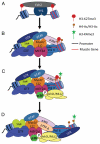Regulating a master regulator: establishing tissue-specific gene expression in skeletal muscle
- PMID: 20716948
- PMCID: PMC3052885
- DOI: 10.4161/epi.5.8.13045
Regulating a master regulator: establishing tissue-specific gene expression in skeletal muscle
Abstract
MyoD is a master regulator of the skeletal muscle gene expression program. ChIP-Seq analysis has recently revealed that MyoD binds to a large number of genomic loci in differentiating myoblasts, yet only activates transcription at a subset of these genes. Here we discuss recent data suggesting that the ability of MyoD to mediate gene expression is regulated through the function of Polycomb and Trithorax Group proteins. Based on studies of the muscle-specific myog gene, we propose a model where the transcriptional activators Mef2d and Six4 mediate recruitment of Trithorax Group proteins Ash2L/MLL2 and UTX to MyoD-bound promoters to overcome the Polycomb-mediated repression of muscle genes. Modulation of the interaction between Ash2L/MLL2 and Mef2d by the p38α MAPK signaling pathway in turns provides fine-tuning of the muscle-specific gene expression program. Thus Mef2d, Six4, and p38α MAPK function coordinately as regulators of a master regulator to mediate expression of MyoD target genes.
Figures

Similar articles
-
p38α MAPK disables KMT1A-mediated repression of myogenic differentiation program.Skelet Muscle. 2016 Aug 22;6:28. doi: 10.1186/s13395-016-0100-z. eCollection 2016. Skelet Muscle. 2016. PMID: 27551368 Free PMC article.
-
The Notch effector Hey1 associates with myogenic target genes to repress myogenesis.J Biol Chem. 2010 Jan 8;285(2):1249-58. doi: 10.1074/jbc.M109.046441. Epub 2009 Nov 16. J Biol Chem. 2010. PMID: 19917614 Free PMC article.
-
Requirement of decreased O-GlcNAc glycosylation of Mef2D for its recruitment to the myogenin promoter.Biochem Biophys Res Commun. 2013 Apr 19;433(4):558-62. doi: 10.1016/j.bbrc.2013.03.033. Epub 2013 Mar 22. Biochem Biophys Res Commun. 2013. PMID: 23523791
-
Regulation and functions of myogenic regulatory factors in lower vertebrates.Comp Biochem Physiol B Biochem Mol Biol. 2001 Aug;130(1):1-12. doi: 10.1016/s1096-4959(01)00412-2. Comp Biochem Physiol B Biochem Mol Biol. 2001. PMID: 11470439 Review.
-
Targeted inactivation of myogenic factor genes reveals their role during mouse myogenesis: a review.Int J Dev Biol. 1996 Feb;40(1):345-53. Int J Dev Biol. 1996. PMID: 8735947 Review.
Cited by
-
Turning on myogenin in muscle: a paradigm for understanding mechanisms of tissue-specific gene expression.Comp Funct Genomics. 2012;2012:836374. doi: 10.1155/2012/836374. Epub 2012 Jun 28. Comp Funct Genomics. 2012. PMID: 22811619 Free PMC article.
-
MiR-18 inhibitor promotes the differentiation of bovine skeletal muscle-derived satellite cells by increasing MEF2D expression.J Anim Sci. 2022 Nov 1;100(11):skac238. doi: 10.1093/jas/skac238. J Anim Sci. 2022. PMID: 35797991 Free PMC article.
-
The interaction of MYC with the trithorax protein ASH2L promotes gene transcription by regulating H3K27 modification.Nucleic Acids Res. 2014 Jun;42(11):6901-20. doi: 10.1093/nar/gku312. Epub 2014 Apr 29. Nucleic Acids Res. 2014. PMID: 24782528 Free PMC article.
-
CAT7 and cat7l Long Non-coding RNAs Tune Polycomb Repressive Complex 1 Function during Human and Zebrafish Development.J Biol Chem. 2016 Sep 9;291(37):19558-72. doi: 10.1074/jbc.M116.730853. Epub 2016 Jul 12. J Biol Chem. 2016. PMID: 27405765 Free PMC article.
-
Epigenetic control of myogenic identity of human muscle stem cells in Duchenne muscular dystrophy.iScience. 2024 Nov 8;27(12):111350. doi: 10.1016/j.isci.2024.111350. eCollection 2024 Dec 20. iScience. 2024. PMID: 39650736 Free PMC article.
References
-
- Tapscott SJ. The circuitry of a master switch: Myod and the regulation of skeletal muscle gene transcription. Development. 2005;132:38–40. - PubMed
-
- Rudnicki MA, Schnegelsberg PN, Stead RH, Braun T, Arnold HH, Jaenisch R. MyoD or Myf-5 is required for the formation of skeletal muscle. Cell. 1993;75:1351–1359. - PubMed
-
- Davis RL, Weintraub H, Lassar AB. Expression of a single transfected cDNA converts fibroblasts to myoblasts. Cell. 1987;51:987–1000. - PubMed
-
- Lassar AB, Davis RL, Wright WE, Kadesch T, Murre C, Voronova A, et al. Functional activity of myogenic HLH proteins requires hetero-oligomerization with E12/E47-like proteins in vivo. Cell. 1991;66:305–315. - PubMed
Publication types
MeSH terms
Substances
Grants and funding
LinkOut - more resources
Full Text Sources
Other Literature Sources
Miscellaneous
